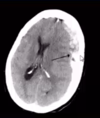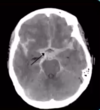CNS 1 (Sept 26) Flashcards
(59 cards)
What does the peripheral NS consist of?
-mixed spinal nerves carrying: a) sensory information from the body, such as muscles and skin (afferent) and b) motor information from CNS to the body to get it to move (efferent)
What does central NS consist of?
-brain -spinal cord
What are glial cells?
-they support the neurons -4x more of these than neurons themselves -brain consists both of neurons and these glial cells
What are ependymal cells?
-inside of lining of ventricular system containing the CSF -form a barrier between CSF and the brain itself -CSF brain barrier -also produce fluid contained in ventricular system (CSF) -found in CNS grey matter
What are astrocytes?
-make contact with blood vessels and form blood brain barrier -performs barrier to prevent things from poisoning the neurons -can trick astrocytes- dissolve things in membrane then it gets across blood brain barrier (eg. alcohol) -found in CNS grey matter
What are microglia cells?
-blood brain barrier prevents immune system from getting into brain -provide intrinsic immune capacity of the brain -white matter of CNS
What are oligodendrocytes?
-need fast conduction of signal -myelin is derived from oligodendrocyte -one oligodendrocyte sends off many arms which wrap around multiple axons to provide myelination -white matter of CNS
Which axons are unmyelinated?
-neurons carrying pain and temperature
What are Schwann cells?
-one Schwann cell ensheaths only one axon -myelination in the PNS
How is immunity addressed in the PNS?
-no blood brain barrier in PNS so you have opportunity for blood to interact with PNS -blood contains T cells, macrophages, etc. -able to be mobilized to fight infection and injury in PNS
Why is CNS regeneration limited?
-neurons are postmitotic (rare to get new ones growing) -glia inhibit axon growth (injury of CNS, loss for causing any regeneration/making new synapses to make new function) -brain is formed carefully during development so you don’t want to have new axons being formed everywhere -CNS purposefully limits regeneration
Describe regeneration in the PNS
-1mm/day -neurons can sprout collaterals and regenerate (if you injure axon, axon can regenerate or you can get collaterals growing from adjacent uninjured neurons) -nerve growth factor promotos attraction of new neurons from collaterals or regeneration -glia produce growth factors -macrophages remove debris (from blood- get rid of old dead cells that would inhibit regrowth)
What body cavity is CNS located in?
-dorsal body cavity -protected by structures that make up the dorsal body cavity which for the head is the skull and for the spinal cord is the vertebral column
Label from top to bottom and give description of function of each

- cerebral cortex: outside of the brain, involved in: thinking, memory, voluntary motor movements, sensory perception
- diencephalon: deep within brain grey matter, sensory/motor relay centre to and from cortex, autonomic functions
- brainstem: midbrain, pons, and medulla- autonomic functions, cranial nerve nuclei contained in here which are responsible for generating function in head/neck
- cerebellum: coordination of movement and balance
- spinal cord: motor output, sensory input, reflexes and interface with PNS
What is meninges?
- three layers
- inside skull
- protection
What is dura mater?
- firmly attached to the skull
- has no instrinsic pain or ability to feel anything (but meninges does)
What is located between the dura and the skull?
- meningeal veins, arteries, and nerves (neurovascular bundle)
- supplying dura
What lines the dura?
- arachnoid mater
- small spider like extensions that separate the arachoid from brain
What membrane covers the brain?
- pia mater
- covers cerebral vessels
- thin translucent membrane
What is the falx cerebri?
-extension of the dura that divides the left and right cerebral hemispheres
What is the tentorium cerebelli?
-extention of dura that separates cerebellum and cerebrum
What happens when we get a space occupying lesion in the brain such as a tumour or hematoma?
- herniation
- causes part of the brain to move into different compartment
- damages CNS
What occurs when you lose pressure within the skull?
- Brain can drop down and cause tentorial hernation
- Coning- brainstem falls down and hits bones (through foramen magnum)
What are cerebral vessels and where do they originate from?
- blood vessels on surface of brain
- derived from internal carotid artery













